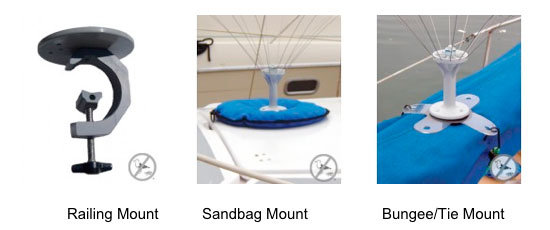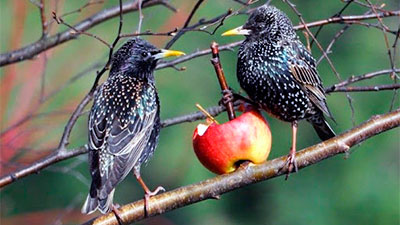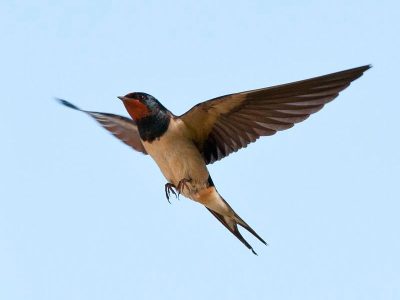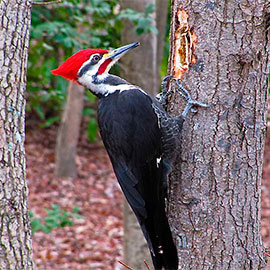Dealing with seagull problems can be frustrating for homeowners, business owners, and boaters alike. These intelligent, adaptable birds can quickly become a nuisance with their loud calls, aggressive behavior, and messy droppings. This comprehensive guide explores effective, humane methods how to get rid of seagulls — from understanding their behavior patterns to implementing practical solutions that work for your specific situation. Additionally, it is important to recognize that while addressing seagull issues, you might also encounter other birds that can pose challenges, such as sparrows. This guide will also touch upon how to eliminate sparrows effectively, ensuring that you have a holistic approach to managing bird-related concerns. By employing a combination of deterrents and environmental adjustments, you can create a more peaceful outdoor space.
Quick Picks: Best Seagull Deterrents
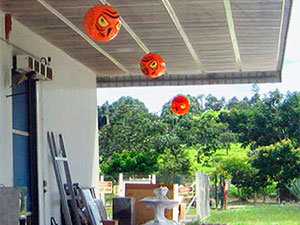
Best Visual Deterrent
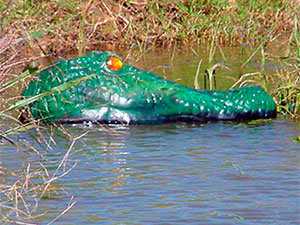
Best for Water Areas
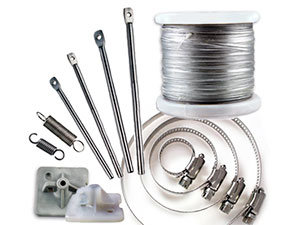
Best for Buildings
- Understanding Seagull Behavior: Know Your “Enemy”
- Why Seagulls Become a Nuisance
- Prevention: Eliminating Attractants
- How to Get Rid of Seagulls – Deterrent Methods
- Commercial Seagull Deterrents for Properties
- Specialized Solutions for Boats and Marine Areas
- Seasonal Approach to Seagull Control
- Creating A Multi-Layered Defense Strategy
- When to Call a Professional
- Frequently Asked Questions
- Conclusion: Creating an Effective Seagull Management Plan
Understanding Seagull Behavior: Know Your “Enemy”
Seagulls (or gulls) are highly intelligent birds belonging to the Laridae family. Their remarkable ability to adapt to different environments makes them particularly challenging to deter. Before attempting any control method, it’s essential to understand what attracts them to your property and how they behave.
Species & Distribution
Medium to large birds with typically gray or white plumage and black markings. At least 28 species in North America alone, found breeding on every continent including the Arctic.
Nesting Habits
Dense, noisy colonies with 2-3 eggs per nest. Extremely territorial during breeding season, which typically spans 3-5 months in spring and summer.
Feeding Behavior
Opportunistic omnivores that eat almost anything—from fish and insects to human food waste. Can feed on land, in water, or during flight.
Because seagulls are intelligent and adaptable, the most effective deterrent strategies combine multiple methods and rotate them regularly to prevent habituation.
Why Seagulls Become a Nuisance
While traditionally coastal birds, many seagull species have adapted to urban environments, creating numerous problems for property owners:
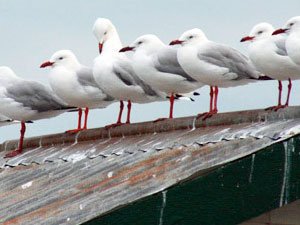
Property Damage
- Acidic droppings corrode building materials
- Stains and deteriorates paint finishes
- Blocks gutters with nesting materials
- Accelerates wear on roofing materials
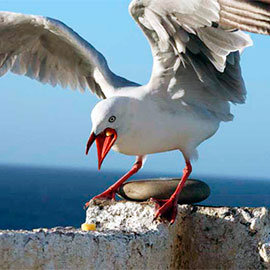
Health Risks
- Droppings harbor E. coli and Salmonella
- Fungal pathogens in accumulated waste
- Parasites can spread to humans
- Creates slippery, hazardous surfaces
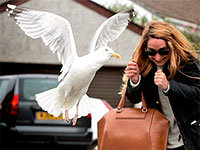
Behavior Issues
- Loud calls from pre-dawn to after dusk
- Dive-bombing during nesting season
- Aggressive food-seeking behavior
- Significant noise pollution from colonies
Seagulls are protected under the Migratory Bird Treaty Act in the United States and similar wildlife protection laws worldwide. Always use legal, humane deterrent methods rather than harmful control measures. Disturbing active nests, eggs, or harming gulls can result in significant fines.
Prevention: Eliminating Attractants
The foundation of effective seagull control is making your property less appealing to these opportunistic birds. Before investing in deterrents, focus on these preventative measures:
Food Management: The Key to Prevention
Eliminating food sources is the single most effective way to discourage seagulls from frequenting your property:
- Use wildlife-proof garbage containers with tight-fitting lids
- Clean up food scraps immediately after outdoor meals
- Post signs prohibiting bird feeding in public areas
- Secure waste management systems at food processing businesses
- Never leave pet food outdoors unattended
Strategic Habitat Modifications
Altering your property to make it less accommodating to gulls can significantly reduce problems:
Implement preventive measures before nesting season begins. Once seagulls establish nests, legally removing them becomes much more complicated due to wildlife protection laws.
How to Get Rid of Seagulls – Deterrent Methods
Before investing in commercial products, try these cost-effective deterrent methods you can implement yourself:
| Deterrent Type | How to Implement | Effectiveness | Best For |
|---|---|---|---|
| Reflective Objects | Hang old CDs, aluminum foil strips, or reflective tape in problem areas | Medium (requires regular repositioning) | Yards, gardens, small open areas |
| DIY Predator Decoys | Position plastic owls or hawk figures, moving them regularly | Medium-Low (habituation occurs quickly) | Rooftops, docks, open spaces |
| Fishing Line Grid | Install fishing line in a grid pattern (12-18″ spacing) across landing areas | High (physical barrier) | Specific landing areas, small spaces |
| Wind Chimes/Noise Makers | Hang wind chimes or other noise-making devices in problem areas | Medium (most effective when combined with visual deterrents) | Porches, patios, small areas |
| Homemade Repellent Sprays | Cayenne pepper or white vinegar mixed with water, sprayed on surfaces | Medium-Low (requires frequent reapplication) | Railings, small ledges, limited areas |
Rotate and vary your deterrent methods. Seagulls are intelligent and quickly become accustomed to static deterrents, especially visual ones that don’t move or change position.
For the best results, combine multiple deterrent types simultaneously. A strategic approach using visual, auditory, and physical deterrents creates a multi-sensory discouragement that seagulls find difficult to ignore or become accustomed to over time.
Commercial Seagull Deterrents for Properties
When DIY methods aren’t enough, these proven commercial solutions offer more reliable deterrence:
Bird-X Terror Eyes Predator Balloon
Best Visual DeterrentHow Does It Work
How to Use
- Inflate and hang from poles, trees, or other elevated structures
- Position 3-5 feet above areas where seagulls gather
- Move the device to new positions every few days to prevent habituation
- Install before seagulls establish nesting patterns for best results
- No power source required - operates with wind movement
- Effective deterrent for open spaces where visibility is unobstructed
- Lightweight and portable - easy to reposition
- Weather-resistant construction for outdoor use
- Birds may become accustomed to it if not regularly moved
- Less effective in windless conditions
- May be less effective against gulls already nesting in the area
Bird-X Gator Guard
Best for Water AreasHow Does It Work
How to Use
- Simply place the Gator Guard in the water area you want to protect
- Attach the included anchor line if needed to prevent drifting
- For larger water areas, use multiple units spaced appropriately
- Reposition occasionally to maximize effectiveness
- No electricity or batteries required
- Highly visible from all angles
- Weather-resistant construction for long-term use
- Effective for ponds, pools, and small lakes
- May require replacement after extended sun exposure
- Gulls may eventually habituate if the deterrent remains stationary
- Less effective for very large water areas without multiple units
Bird-X Bird Wire System
Best for BuildingsHow Does It Work
How to Use
- Install along building ledges, parapets, signs, and other landing surfaces
- Follow spacing guidelines for maximum effectiveness
- Professional installation recommended for optimal results
- Regular inspection ensures continued functionality
- Nearly invisible from ground level - maintains building aesthetics
- Highly effective physical barrier with long-term results
- Durable stainless steel construction resists weathering
- No habituation issues like with visual or sound deterrents
- Higher initial installation cost compared to other deterrents
- May require professional installation for optimal effectiveness
- Requires appropriate spacing for target bird species
Specialized Solutions for Boats and Marine Areas
Boats and marine environments require specialized approaches to seagull management:
SCS Wind Powered Seagull Deterrent
Best for BoatsHow Does It Work
How to Use
- Install on boat canopies, cabin tops, or other flat surfaces
- Position at the highest point possible for maximum visibility
- Available in different mounting configurations for various boat types
- No electricity or batteries required
- Specifically designed for marine environments
- Durable construction withstands saltwater exposure
- No power source needed - works with natural wind
- Lightweight and won't affect boat performance
- Less effective in completely windless conditions
- May require multiple units for larger vessels
- Occasional cleaning needed to maintain reflective properties
Clean bird droppings from your boat promptly. The acidic nature of seagull waste can damage gelcoat, canvas, and other boat surfaces if left untreated. A solution of one part white vinegar to four parts water can help neutralize the acid before cleaning.
Boat-Specific DIY Solutions
Try these cost-effective methods to protect your vessel:
- Monofilament Line Grid: Create a “ceiling” of fishing line above your boat when docked
- Old CD Mobile: Hang CDs on strings around the boat to create reflective movement
- Boat Covers: Use covers with built-in support poles to prevent pooling water (which attracts birds)
- PVC Pipe “Roosting Guards”: Install PVC pipes at an angle along railings to create unstable perches
Seasonal Approach to Seagull Control
Effective seagull management requires adjusting your strategy throughout the year:
Pre-Nesting Season
(Winter/Early Spring)
This is the optimal time for prevention. Install physical deterrents, modify potential nesting areas, and establish waste management routines before gulls select nesting sites.
Nesting Season
(Spring/Summer)
Options become limited once nests are established due to legal protections. Focus on unoccupied areas, maintain vigilance with food management, and consider professional consultation.
Post-Breeding Season
(Late Summer/Fall)
Clean and sanitize previously nested areas, install permanent deterrents, evaluate current strategy effectiveness, and repair any damage before the next breeding cycle.
Active nests with eggs or young birds are legally protected. Focus prevention efforts before nesting occurs or after young birds have fledged to avoid legal complications.
Creating A Multi-Layered Defense Strategy
The most effective seagull management combines multiple approaches in strategic layers:

Layer 1: Habitat & Food Management

Layer 2: Physical Barriers
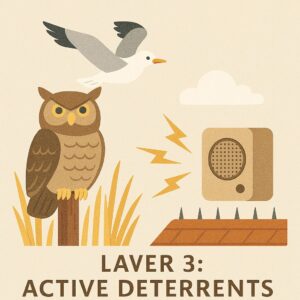
Layer 3: Active Deterrents
This layered approach creates multiple obstacles for seagulls, making your property significantly less attractive than neighboring alternatives. The key is consistency—maintaining all layers simultaneously rather than relying on a single solution.
Seagulls are creatures of habit. It may take 2-3 weeks of consistent deterrent use before they permanently change their behavior patterns and seek alternative locations.
When to Call a Professional
While many seagull problems can be addressed with DIY methods, some situations warrant professional intervention:
Professional bird control specialists can offer:
Frequently Asked Questions
Are seagulls protected by law?
Yes, seagulls are protected under the Migratory Bird Treaty Act in the United States and similar wildlife protection laws in many other countries. These laws make it illegal to harm, capture, or kill gulls without proper permits from wildlife authorities.
While you can freely use non-lethal deterrents, any intervention that involves handling birds, eggs, or nests typically requires authorization from appropriate wildlife management agencies. Violations can result in significant fines and penalties.
What naturally deters seagulls?
Several natural deterrents can help discourage seagulls:
- Natural predator presence (such as falcons or eagles in the area)
- Certain plant species like thorny bushes that prevent comfortable landing
- Modifications to the landscape that eliminate open spaces
- The complete absence of food sources and feeding opportunities
- Dark or reflective surfaces that create visual discomfort
How do I keep seagulls off my roof?
Preventing seagulls from roosting on your roof requires a multi-faceted approach:
- Install physical barriers like bird spikes or wire systems along ridgelines and edges
- Use visual deterrents such as reflective objects or predator decoys
- Apply bird-safe repellent gels on favorite perching spots
- Regularly change the position of visual deterrents to prevent habituation
- Consider installing sloped additions to flat roof sections where gulls frequently land
What sounds scare seagulls away?
Seagulls are sensitive to certain sounds that suggest danger:
- Recordings of predator birds (eagles, hawks, falcons)
- Gull distress calls, which alert other gulls to potential danger
- Random, unexpected loud noises (though these may disturb neighbors)
- Ultrasonic deterrent devices specifically calibrated for gulls
For maximum effectiveness, combine sound deterrents with visual methods and rotate sound patterns to prevent habituation.
Can I remove a seagull nest from my property?
In most jurisdictions, removing active seagull nests (those containing eggs or chicks) is illegal without proper permits due to protections under wildlife conservation laws. However, you can:
- Remove nesting materials before eggs are laid (during the early building phase)
- Apply for permits from wildlife authorities if nests pose genuine health or safety risks
- Contact professional wildlife management services for legal guidance
- Implement deterrents after the breeding season to prevent future nesting
What should I do if a seagull attacks me?
Seagulls primarily become aggressive when protecting nests or chicks, or when conditioned to expect food. If a seagull attacks:
- Maintain eye contact with the bird while calmly but quickly leaving the area
- Hold an object like an umbrella or bag above your head as a shield
- Avoid running erratically, which may trigger predatory instincts
- Never attempt to harm the bird, as this is illegal and may escalate aggression
- Report repeated aggressive behavior to local wildlife authorities
How do restaurants keep seagulls away from outdoor dining areas?
Restaurants with outdoor seating often use multiple strategies to manage seagull problems:
- Install overhead deterrents like netting, wires, or string grids
- Train staff to clear food promptly and maintain clean tables
- Use visual deterrents around the perimeter of dining areas
- Provide table umbrellas or awnings that limit aerial access
- Post signs asking customers not to feed birds
- Some establishments use trained birds of prey for periodic deterrence (falconry)
Will seagulls eventually go away on their own?
Seagulls are creatures of habit and territorial by nature. Once they establish a feeding or nesting area, they typically won’t leave on their own unless:
- Their food source is completely eliminated
- They consistently encounter effective deterrents
- The nesting season ends (they may relocate temporarily)
- A better, more accessible food source becomes available elsewhere
Without active intervention, seagulls are likely to return to successful feeding and nesting locations year after year.
Conclusion: Creating an Effective Seagull Management Plan
Successfully managing seagull problems requires patience, consistency, and a multi-faceted approach. Follow these steps to develop your own effective strategy:
Effective seagull management is typically a process rather than an instant solution. Expect to see gradual improvement over several weeks as birds adjust their patterns and seek alternative locations.
By understanding gull behavior and implementing a comprehensive, humane deterrent strategy, you can effectively reclaim your property while coexisting responsibly with these protected birds. Remember that your goal is not to harm the gulls but to encourage them to relocate to more natural habitats where they can fulfill their important ecological role without creating conflicts with human activities.
